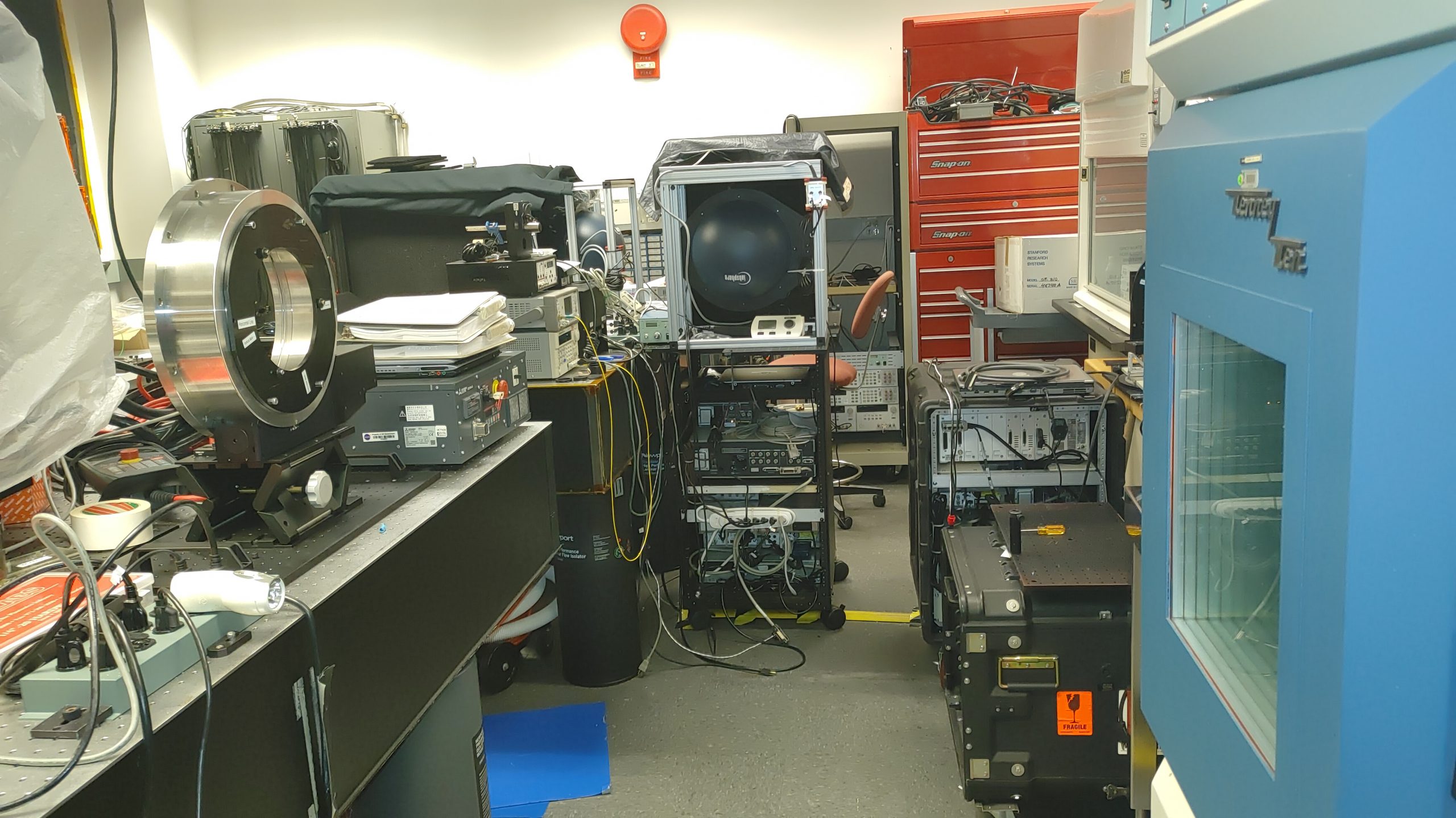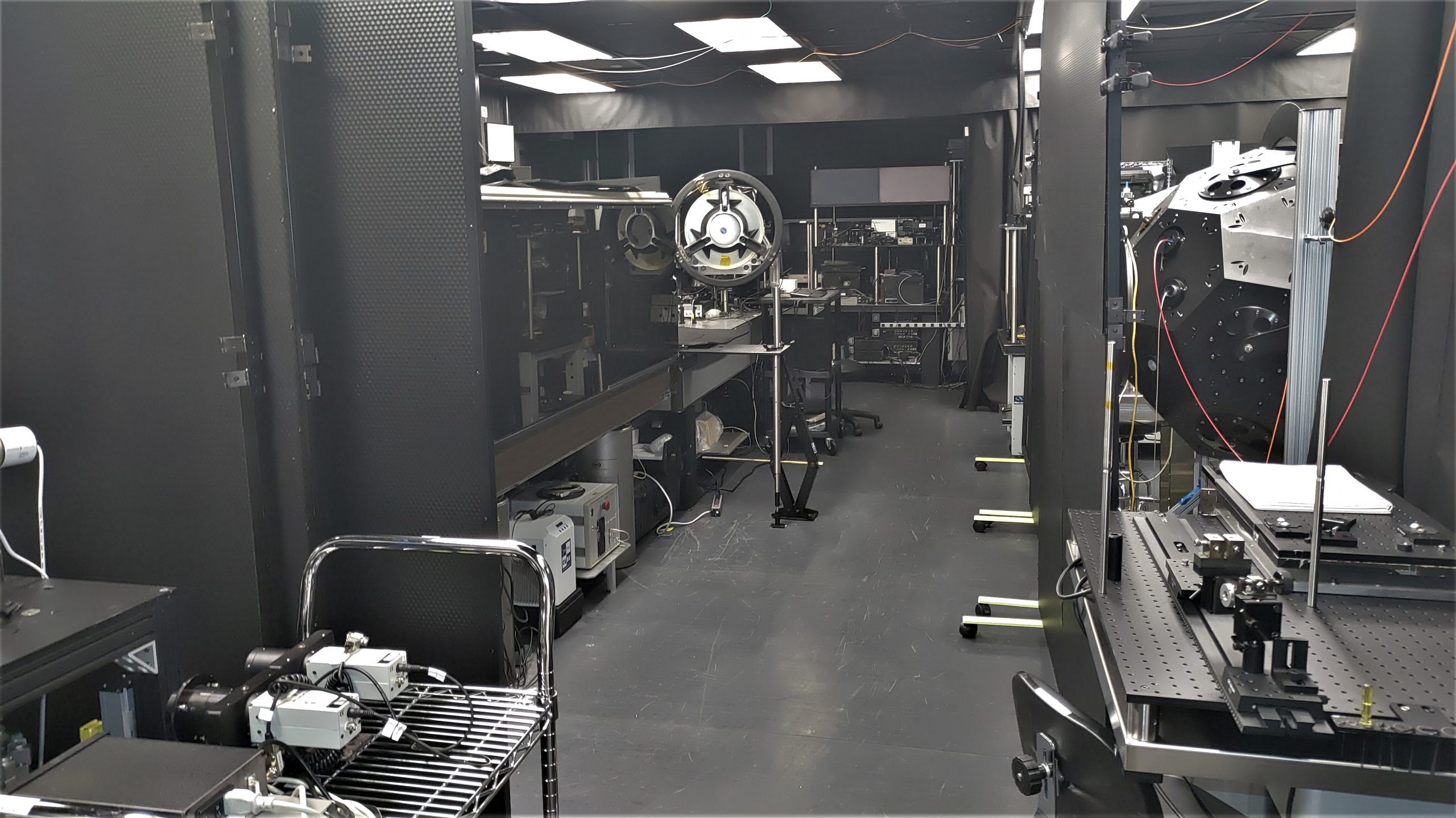Instrument Development and Testing Laboratory (IDTL)
B323

The IDTL is a non-cleanroom laboratory located in room B323 which supports the design, build, and testing of state-of-the-art electro-optical calibration instrumentation and environmental testing of remote sensing instrumentation. The IDTL features a Tenney Environmental Chamber for thermal radiometric performance testing. A 50.8 cm Spectralon-lined integrating sphere called “Venti” is used as a stable, uniform light source for thermal testing instruments in the Tenney chamber. An LED-illuminated integrating sphere source employing 4 LEDs operating at different wavelengths in the visible and near infrared is used in determining instrument non-linearity. The IDTL also contains a 122 cm by 244 cm optical bench for breadboarding and testing and calibrating instruments as well as a Class 100 clean bench, fume hood, a large variety of reflective and refractive optics and mounts, a full suite of electronic test equipment, and tools.
RCL Sphere Lab
D319

The RCL maintains its primary radiometric integrating sphere sources, nicknamed “Slick” and “Grande”, in room D319, a class 10,000 cleanroom. These are Spectralon-lined, 101.6 cm diameter sources with 25.4 cm diameter apertures. The spheres are calibrated and characterized for radiance output uniformity over their complete aperture areas in 1 cm increments at eight selected wavelengths. Slick has four lamp output intensity levels, and Grande has eight levels with an additional lamp equipped with an attenuator for fine-tuning of light output. These sources can approximate intensities ranging from dark scenes such as sunlit sea surface, bright scenes such as sunlit cloud tops, and higher intensities for calibrating sun photometers and spectrometers. The RCL currently uses both an OL 750S single, and a 750D double monochromator to calibrate most sphere sources at GSFC and in the field.
RCL Main Lab
D327

The largest of the CF class 10,000 cleanrooms, D327, contains a suite of spectrometers, collimators, filter radiometers, trap detectors, and tuneable and white light laser sources. A 16″ diameter Large Area Collimator (LAC) is used for radiometric, spectral and field-of-view (FOV) characterizations. The LAC can be fiber fed from lasers or used with white light sources when positioned at the LAC focal point. The cleanroom contains a tuneable, intensity-stabilized, quasi-continuous wave laser system, patterned after the Spectral Irradiance and Radiance Responsivity Calibrations using Uniform Sources (SIRCUS) system at NIST and referred to as SIRCUS-G (SIRCUS-Goddard). SIRCUS-G is used in instrument system-level absolute and relative radiometric responsivity characterizations and wavelength calibrations, and provides light across the majority of the wavelength range from 234 nm and 3300 nm. The bandwidth of the light from SIRCUS-G is 5 nm when running in femtosecond mode and < 1 nm when running in picosecond mode. A computer controlled Ekspla NT242 tuneable laser system has a 7-nanosecond pulsewidth with 1 KHz repetition rate and is used for applications that desire faster wavelength tuning with relaxed continuous wave requirements. RCL in-house built Filter Radiometer Measurement Systems (FRMS) are used to monitor RCL and user sources for stability and uniformity at selected FRMS wavelengths, nominally 410, 440, 460, 550, 640, 780, 840, 1050, 1240, 1380, 1550, and 1640 nm. The Source Aperture Mapper (SAM) is a computer-controlled instrument employing a large XY translation stage in combination with an FRMS. The SAM is used for mapping uniformity of sphere apertures at 1 cm intervals both at GSFC and in the field. A number of compact, transportable spectroradiometers are available for monitoring SIRCUS-G wavelengths and calibrating radiance between sphere and collimated sources. These include spectroradiometers from Analytical Spectral Devices (ASD), Avantes, Ocean Optics, and Instrument Systems CAS.
CF Diffuser Calibration Lab (DCL)
D327A

The Diffuser Calibration Laboratory (DCL), located in the D327A class 10,000 cleanroom, houses a unique, state-of-the-art, complete out-of-plane optical scatterometer capable of measuring the bi-directional scatter distribution function (BSDF) of transmissive or reflective, specular or diffuse optical elements, man-made and natural surfaces in addition to granular, powdered, or liquid samples. The current operating wavelength range of the DCF is 230 nm to 1700 nm. The laboratory is a secondary standards calibration facility, the primary standard facility being the Spectral Tri-function Automated Reflection Radiometer (STARR) facility located at the National Institute for Standards and Technology (NIST) in Gaithersburg, Maryland. The BSDF measurement uncertainty realized in the DCL using this scatterometer is 0.7% (k=1). The DCF scatterometer also provides the capabilities of raster scanning reflective and transmissive samples to determine their BSDF uniformity and measuring the directional/hemispherical reflectance of samples, a Perkin-Elmer spectrophotometer for rapid characterization of specular and diffuse, reflective and transmissive optical components covering the spectral range from 190 nm to 3300 nm, and vacuum-based, solar and VUV materials exposure optical testing/monitoring capability. This capability employs the combination of a small, clean, oil-free vacuum system, solar simulator and vacuum ultraviolet (VUV) sources, coupled with the optical scatter measurement capabilities of the DCL scatterometer and Perkin-Elmer spectrophotometer.
